Creating the Content Machine and Organic Search Series
Organic Search for Publishers is an eight part series designed to help you and your publishing organization develop and implement an effective content machine strategy. The blog series and transcripts are adapted from a podcast series 2040 Digital created for Subscription Insider. To subscribe and listen to the podcast series (all eight episodes are available) visit our page, Subscription Insider or go to iTunes.
The series offers detailed instruction for anyone producing content: for editorial teams, marketing teams, sales teams, audience development teams, circulation teams, and those who manage them.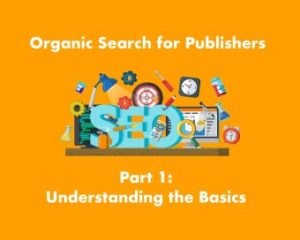
Part One Introduction: Understanding the Basics
The crux behind the series is the importance of adapting to digital consumption behaviors and preferences and promoting readiness of publishers to meet their current or targeted audience’s needs and desires. The efforts do indeed lead to increased performance, increased relevance and of course, more revenue.
Throughout, we will focus on the goals of creating audience engagement, defining what engagement is and how to achieve it, how to extend the digital reach of content, moving beyond a client base of customers that are reached from a print perspective, and then utilize content that has been developed over time to increase the level of specific and holistic relevance (which in turn allows you to increase revenue and value).
The sum and parts of which leads to a gain in value proposition, not just to current members, subscribers and customers but also to prospects that may come to a website both organically or via referral.
Fundamentally with digital, everything has changed and it’s changing very rapidly. Failure to take action is really at your own peril. Your competitors real of perceived are probably already moving in the directions I am recommending throughout this series.
Today’s Digital and Content Environment
Prior to digital, the member, subscriber and customer was relatively uninformed, and in that regard, if someone put out a piece of marketing, or someone saw something in a television commercial, there was a greater correlation to ultimate loyalty and conversion, because of the messages being given. They didn’t have additional information or reference points to fall back on. They had to believe and trust you.
In today’s environment, the member, subscriber and customer is highly well informed. All the research and behavioral analysis shows that customers, subscribers and members, regardless of focus, are indeed researching more before they engage with you in a digital or physical sense.
The behaviors aren’t just correlated to “purchasing a product”.
They transcend to judging your authority and credibility and if and how your content is consumed.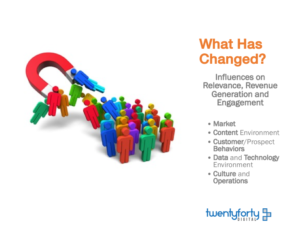
It is a significant challenge for companies to adapt to that great knowledge, choice and awareness that these customers now have…simply just walking in the door, getting your publication in the mail or before coming to your website.
That has upended perceptions and clouded the understood reality around what the member/customer/subscriber journey is and how to move prospects through the consumption or purchase funnel.
In pre-internet days the member/customer/subscriber journey was very linear.
It started with mail, particularly direct mail campaigns or phone campaigns where Sales was actively seeking to engage and have a conversation.
It changed slightly when email became available but fundamentally the entire marketing and sales process remained traditional in focus.
It was highly personal then as you and your staff had the opportunity to actually “touch” or “converse” with the prospect.
A direct relationship could be created.
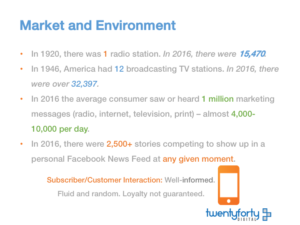 Our world remains highly relationship based, but how that all works and functions in a digital dominated world is very different.
Our world remains highly relationship based, but how that all works and functions in a digital dominated world is very different.
In today’s environment, everything is very fluid and random. At times “high-touch” but most often “low-touch”.
Back to customers, members or subscribers: their processes and behaviors follow a new path.
They are starting with Google, they are starting with email, they are starting with social or mobile. You can’t predict where and when they are going to engage or really even how they will engage. It doesn’t matter whether you classify them as B2C, B2B or B2P customers or prospects.
In the pre-internet days necessity really drove conversion, commitment and loyalty.
In the case of a publisher, a current or prospect subscriber may have only known that there were one or two publications about particular subject matter. In the case of an association, where you already had members lining up, there may have been one or two journals.
Those publications were something people intimately relied on and immediately formed loyalty to believing in the credibility of that content.
In today’s environment, a very “Googlized” environment, people are much more aware of the variety, choice and free resources that they can easily discover. The loyalty concept is very different.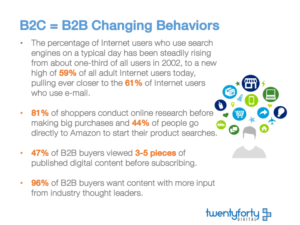
So, just to give some context around how significantly things have changed and offer some historical comparison; in 1920 there was only one radio station. Technology was new, people’s consumption and comfort with gaining content and knowledge in that form was very new and of course limited choices were available.
Jump forward to 2017 and there are almost 16,000 radio stations (registered with the FCC).
So, going back to 1920, people had one choice. Just five years ago, people had 15,000 choices and now they have 16,000 choices. That is a lot of choice and each of those choices is competing for attention and each of those choices is offering content.
Let’s look at another example, in 1946 America had 12 broadcasting stations, in 2017 there were over 1700.
If anybody has cable or satellite, you know that you have upwards of a thousand channels, you now have on demand and subscription services and a deep trove of content available at your fingertips; so again that loyalty concept in pre-internet days is no longer relevant because of the amount of choice that people have in front of them.
Again, staying with the quantity of choices available, the way you need to engage, reach, and present content is fundamentally different than what a company would typically be comfortable with in a very physical print based world.
Confounding any marketing and communications plan is that it is very hard to reach prospects and have that message, that marketing copy, that value proposition…. resonate given the high amount of choice.
So, to bring that home even further statistically, in today’s digital realm the average time per day on Facebook is 50 mins.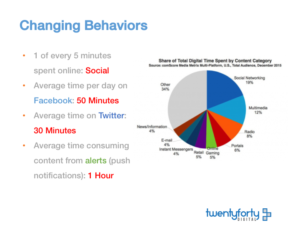
That is significant but that is happening throughout the course of the day when people are finding themselves a bit bored, sitting waiting for an airplane, commuting into work on the subway or at other times where they are finding themselves mentally exhausted and simply wanting to consume a cat video or two.
Once they consume the cat video, they may be looking for some form of engagement and an ability to catch up, not just on personal friends and family but also news and content.
They don’t want to work too hard to find relevant content and they have become very comfortable in having their professional and personal needs met in one platform.
The average time on Twitter is 30 mins further eroding the time that was once available for you to capture someone’s attention.
The challenge with Twitter for any company is that “tweets in a stream” move by so quickly that people wind up taking bits and chunks of information based on what they’re seeing the moment they decide to engage. Twitter has indeed attempted to offer a solution and has taken to sending “summary” emails of what someone may have missed or offering that option when a user opens the website or app.
Now let’s move to “notifications” and “alerts” to further demonstrate choice, the erosion of time and attention and the quantity of information available to consume.
The average time used to consume content from notifications and alerts is one hour per day. Wow, that is a lot but that is what research is showing.
Many of you, like your market targets, are getting alerts and notifications from news services and others on your phone, including the likes of Facebook and Twitter. All of that “pushing” actually leverages goal attainment and the dopamine effect I discussed in a previous post.
The “pushing” of the notification and alert commands attention as the “ding” catalyzes the target to check, open and consume the content.
Are you providing the dopamine or are you sitting back waiting for them to come to you?
The Changed Competitive Digital Landscape
In the realm of digital, and correlating back to pre-internet days, most publishers or any company majorly focused on content (associations and others), with the example I provided of one or two journals, or one or two publications, the concept of competitiveness is now significantly different.
Today there are roughly 48 billion pages on the web at any one time. That is representative of a content explosion and includes those who have decided to become a publisher and offer free content, so you’re looking at an individual who had the opportunity to put forward their voice and thoughts on the web, you are looking at organizations who can now easily mount content up along with your traditional competitors who can easily and quickly add more content.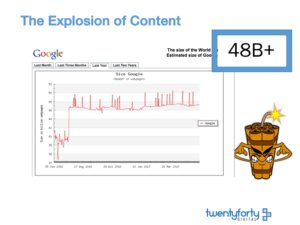
There are provided opportunities where you now intimately know more about what you’re real or perceived competitors are doing, but one does have to recognize the size of the available content is going to be an ongoing challenge and a significant competitive force for any company as the number exponentially continues to tick up.
You have a life and a day job and can’t take all day every day to monitor what new content is available or how “competitive” content is being leveraged.
The Google and Organic Effect
I want to take a moment here to describe what the search environment really looks like.
We have all coined the term “Google” as an action, and a verb.
It is indeed now known and perceived as an “action”.
People have been well trained. They have had success with using Google.
Down to the point that even though someone may know a URL or name for a particular website, they will default to Google being the page that opens when they open their browser, and they will indeed type the organization they seek in the Google search box.
As a tactical aside, the behavioral action can inflate your organic traffic. The resulting analytics should be adjusted to reflect the behavior ensuring you understand your real organic performance.
There is a great comfort and there is a perceived authority that Google has with delivering content that is the most popular or the most relevant to that searchers desires.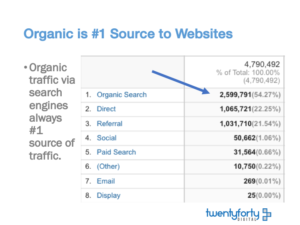
It is a persistent behavior and is becoming more and more pervasive on mobile devices.
Where are we in a, “let’s ask Google first” behavioral mode: If you are in a car having a conversation, no longer do you need to wait until you get home or to the office to pull a book, piece of content, document or a magazine.
Arguments and debates are settled by “what does Google say?”. One may sit there and debate with a peer, with a friend, with a family member and now defer to google to prove their point one way or the other.
It is all based on understood behaviors and well satisfies everyone’s short attention span. It also feeds desire to immediately have the answer because the answer is quickly discoverable.
And that is how fast and how deeply it has ingrained itself into our own behavioral processes in engagement, interaction and discovery.
Any publisher needs to be able to account for what is now ingrained across a connected society.
Back to the significant amount of content on the web. If the content is not well described, if it isn’t SEO maximized or if it doesn’t correlate to the questions that people ask or the terms they use, they won’t find the content, search engines wont present it and they will be directed to content produced by others.
Check out the transcript from Episode One. Don’t want to read? Check out our podcast series page and jump to the recording of each episode.
As Always, we are here to help you with your digital and marketing journey. Contact us today to learn how we create relevance and revenue.


